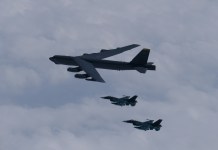In a recently released footage, Ukrainian forces demonstrated deploying ground-based kamikaze unmanned ground vehicle (UGV) to target and demolish a bridge inside Russia-held territory.
The video, first revealed by Ukrainian journalist Andriy Tsaplienko on Telegram, has quickly captured viewers’ interest on various social media platforms, providing insight into the inventive strategies utilized in combat.
The video captures the UGV, laden with explosives, embarking on a mission. In the footage’s opening scenes, a soldier inspects the UGV before it is remotely directed toward its target destination, traversing challenging terrain in adverse weather conditions.
Captured from the vantage point of an aerial drone, the footage documents the UGV’s passage through expansive terrain, where it encounters various obstacles including unexploded ordnance and an abandoned Russian tank along the route.
Nevertheless, despite these challenges, the drone skillfully maneuvers around potential obstacles, offering viewers a surreal perspective of the UGV’s advancement.
⚡️A Ukrainian ground-based kamikaze drone equipped with 55-kilogram explosives crossed 4 km of enemy-controlled territory and disabled a road bridge.💥#UkraineWarNews #UkraineWar #UkraineRussianWar #Ukraine #RussiaIsATerroristState #RussiaIsANaziState pic.twitter.com/VxFlUFTqzL
— ⚔️ Hunter UA ✠ 🇺🇸🇺🇦 (@UaCoins) January 25, 2024
The video’s climax unfolds beneath a road bridge, where the UGV detonates its payload, resulting in a dramatic explosion.
However, the full extent of the damage inflicted upon the bridge remains uncertain, particularly given the UGV’s purported passage through enemy-controlled territory.
Eurasian Times could not independently confirm the reported details depicted in the video. However, the accompanying caption asserted that the vehicle traveled a distance exceeding two miles (nearly 4 km).
This utilization of unmanned technology underscores the evolving nature of modern warfare, wherein unmanned ground vehicles play a pivotal role in executing strategic maneuvers.
From logistical support to targeted strikes, these robotic assets reshape conflict dynamics. Some UGVs, like the THeMIS vehicle used by Ukraine, are explicitly crafted to evacuate wounded soldiers and ferrying provisions.
Unmanned Ground Vehicles In Ukraine War
UGVs serve critical functions in the ongoing conflict, from delivering ammunition to troops to deploying and planting landmines. They also play a pivotal role in neutralizing explosive threats on the battlefield, underscoring their versatility and significance in contemporary warfare.
Russia is also increasing the utilization of such vehicles in the continuing conflict. Last year, Moscow deployed four Marker Unmanned Ground Vehicles (UGVs) to bolster its military operations in Ukraine.
The Marker, weighing three tons and featuring five wheels, is a modular system capable of mounting various armaments such as anti-tank missiles, heavy machine guns, grenade launchers, unmanned aerial vehicle (UAV) launch modules, jammers, or other weaponry.
In December of 2023, a video surfaced on social media channels linked to the Kremlin, allegedly depicting a Russian unmanned ground vehicle (UGV) providing frontline troops with supplies, dodging attacks from Ukrainian mini-drones, and transporting a wounded soldier.
As armed drones and artillery pose threats to troop movements in Ukraine, routine logistical tasks such as supply and evacuation are increasingly vulnerable to attacks.

In response, Ukrainian and Russian military forces are resorting to “do-it-yourself” platforms for these critical operations, noted Sam Bendett, a US-based Center for Naval Analyses research analyst.
Moreover, despite official denials, the noticeable scarcity of volunteers for the armed forces in Russia and Ukraine has drawn global attention to the role of artificial intelligence (AI) and autonomous systems in the Ukrainian conflict.
While some unmanned systems undertake rescue and logistic missions, others involve reaching a target by land, sea, or air and detonating explosives.
Overall, Unmanned Aerial Vehicles (UAVs) have significantly impacted the Ukrainian conflict, often employed for one-way strike missions such as dropping explosives or conducting reconnaissance.
Notably, First Person View (FPV) drone strikes have had a significant impact, and Ukraine has utilized explosive-laden drone boats, known as Unmanned Surface Vessels (USVs), to target Russian vessels at sea.
Experts have also noted the potential for converting manned systems into unmanned ones. Ukraine could repurpose captured Russian military equipment as unmanned vehicles, allowing their use without extensive training.
However, challenges may arise in integrating electrical equipment and sensors, and exploring alternative applications for such equipment, such as manned covert operations, could be worthwhile.
Nonetheless, UGVs represent a rapidly advancing yet relatively new technology, and the extent of their impact remains uncertain.
- Contact the author at ashishmichel(at)gmail.com
- Follow EurAsian Times on Google News




